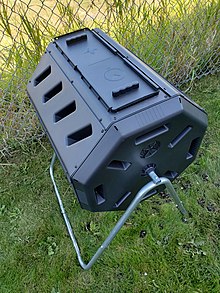From Wikipedia, the free encyclopedia Jump to navigationJump to search Not to be confused with compositing.

Community-level composting in a rural area in Germany

Backyard composter
Compost (/ˈkɒmpɒst/ or /ˈkɒmpoʊst/) is made by decomposing organic materials into simpler organic and inorganic compounds by the microorganisms in a process called composting. This process recycles various organic materials otherwise regarded as waste products. A good compost is rich in plant nutrients and beneficial organisms.
Compost is used to improve the soil fertility in gardens, landscaping, horticulture, urban agriculture and organic farming. The compost is beneficial by providing nutrients as fertilizer to the crop, acting as soil conditioner, increasing the humus or humic acids content of the soil, and most important action of introducing beneficial colonies of microbes in the soil. The natural interaction of the soil, plant roots and nutrient / microorganisms of compost, improves the soil structure. An improved soil structure will increase the soil water retention ability and control soil erosion. Compost can results in land and stream reclamation and ecofriendly wetland construction. As a landfill cover, compost provides a healthy decomposition of waste organic materials.
At the simplest level, the process of composting requires making a heap of a mix of ‘Greens’ and ‘Browns’. Greens are materials rich in nitrogen such as leaves, grass, and food scraps and browns are more woody materials rich in carbon like stalks, paper and wood chips. The materials are wetted to start them breaking down into humus, a process that occurs over a period of months. Most organic standards demand at least a 60 days composting process. However, composting can also take place as a multi-step, closely monitored process with measured inputs of water, air, and carbon- and nitrogen-rich materials. The decomposition process is aided by shredding the plant matter, adding water and ensuring proper aeration by regularly turning the mixture when open piles or “windrows” are used. Fungi, earthworms and other detritivores further break up the material. Aerobic bacteria and fungi manage the chemical process by converting the inputs into heat, carbon dioxide, and ammonium.